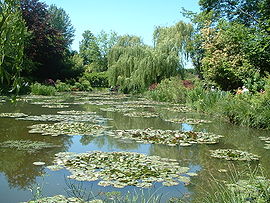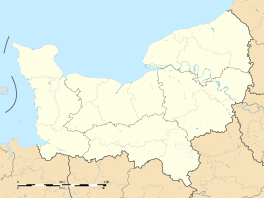Giverny
| Giverny | |
|---|---|

Water lilies in Claude Monet's garden in Giverny
|
|
| Coordinates: 49°04′37″N 1°31′48″E / 49.0769°N 1.53°ECoordinates: 49°04′37″N 1°31′48″E / 49.0769°N 1.53°E | |
| Country | France |
| Region | Normandy |
| Department | Eure |
| Arrondissement | Les Andelys |
| Canton | Écos |
| Intercommunality | Portes de l'Eure |
| Government | |
| • Mayor (2008 - 2014) | Claude Landais |
| Area1 | 6.46 km2 (2.49 sq mi) |
| Population (2008)2 | 502 |
| • Density | 78/km2 (200/sq mi) |
| Time zone | CET (UTC+1) |
| • Summer (DST) | CEST (UTC+2) |
| INSEE/Postal code | 27285 / 27620 |
| Elevation | 10–139 m (33–456 ft) (avg. 17 m or 56 ft) |
|
1 French Land Register data, which excludes lakes, ponds, glaciers > 1 km² (0.386 sq mi or 247 acres) and river estuaries. 2Population without double counting: residents of multiple communes (e.g., students and military personnel) only counted once. |
|
1 French Land Register data, which excludes lakes, ponds, glaciers > 1 km² (0.386 sq mi or 247 acres) and river estuaries.
Giverny (French pronunciation: [ʒi.vɛʁ.ni]) is a commune in the Eure department in northern France. It is best known as the location of Claude Monet's garden and home.
Giverny sits on the "right bank" of the River Seine where the river Epte meets the Seine. The village lies 80 km (50 mi) from Paris, west and slightly north, in the old province of Normandy (it is officially in the département of Eure, in the région of Haute-Normandie).
A settlement has existed in Giverny since neolithic times and a monument uncovered attests to this fact. Archeological finds have included bootees dating from Gallo-Roman times and to the earlier 1st and 2nd centuries AD. The town was known in ancient deeds as "Warnacum". The cultivation of grapes has been an occupation of the inhabitants of Giverny since Merovingian times. The village church dates from the Middle Ages and is built partially in the Romanesque style, though additions have since been made. It is dedicated to Sainte-Radegonde. The village has remained a small rural setting with a modest population (numbering around 301 in 1883 when Monet discovered it) and has since seen a boom in tourism since the restoration of Monet's house and gardens.
...
Wikipedia


